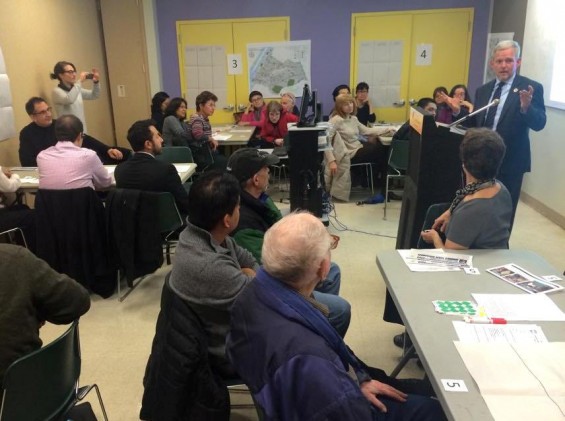
Van Bramer at participatory budget meeting
Dec. 3, 2014 By Christian Murray
Long Island City residents—along with those in Sunnyside and Woodside—have put together an extensive list as to how to spend $1 million in city funds on the district.
Councilman Jimmy Van Bramer, who typically receives about $3.5 million each year to spend on projects throughout the district, has put $1 million in the hands of residents to decide how the funds should be spent.
Nine meetings were held throughout Sunnyside, Woodside and Long Island City this fall, and hundreds of attendees put forward an array of ideas.
This is the first time the public has weighed in on how these funds should be spent in the 26th Council district–in a process called participatory budgeting.
“Participatory budgeting is democracy in action,” said Councilman Jimmy Van Bramer in a statement, adding that it has been an exciting process “to participate, discuss and debate which projects are needed.”
The ideas put forward include:
- A small boat ramp for kayaks, canoes, etc. on the Long Island City waterfront
- Beautification projects and streetscape improvements—including the planting of new street trees throughout the district
- Installation of traffic calming measures throughout the district
- A pedestrian footbridge over Queens Boulevard and Thomson Avenue
- Expansion of bike lanes throughout the district
- Renovation of the tennis courts at IS 204 in Dutch Kills
- Solar powered charging stations throughout district
- A Mobile Veterinarian
- A second dog run in Sunnyside
- Handicap-accessible ramps in Queensbridge Houses.
These ideas will be whittled down by about 140 budget delegates in concert with Van Bramer and various city agencies. These delegates were not elected or appointed; they just put their names forward at the meetings or called Van Bramer’s office.
Their task is to take the best ideas and transform them into formal proposals by March—based on their cost and popularity. All proposals must cost at least $35,000 and be less than $500,000.
In March, a series of draft proposals will be presented to the community. The delegates will incorporate this feedback before presenting their final proposal.
The community will then get to vote on the final proposals in April.
Residents will then be able to vote on the project(s) of their choice.
One Comment

how about a basic accounting class for Van Bramer to learn to read the financial report.